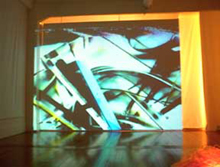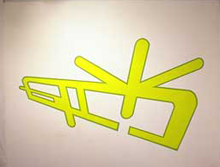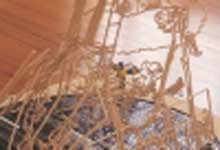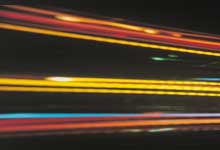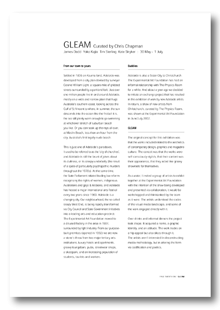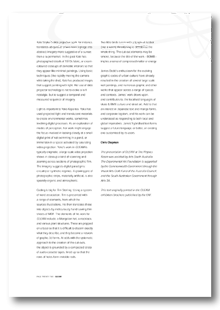 |
|||||||||
|
|
| ...GALLERY EXHIBITS 2001 | ...GLEAM - an essay by Chris Chapman | |||||||||||||
|
GLEAM
- an essay by Chris Chapman 30 May - 30 June 2001 From our town to yours Settled in 1836 on Kaurna land, Adelaide was developed from a city plan devised by surveyor Colonel William Light: a square mile of gridded streets surrounded by a parkland belt. Just over one million people live in and around Adelaide, mostly on a wide and narrow plain that hugs Australia's southern coast, looking across the Gulf of St Vincent to where, in summer, the sun descends into the ocean like the fireball it is, the sea still plenty warm enough to go swimming at whichever stretch of suburban beach you like. Or you can soak up the rays all over, at Maslin Beach, less than an hour from the city, Australia's first legally nude beach. This is just one of Adelaide's paradoxes. It used to be refered to as the 'city of churches', and Adelaide is still the brunt of jokes about its dullness, or its creepy underbelly (the result of a spate of particularly psychopathic murders throughout the 1970s). At the same time, the State Parliament initiated leading law reforms recognising the rights of women, indigenous Australians and gays & lesbians; and Adelaide has hosted a major international arts festival every two years since 1960. Adelaide is a changing city. Our neighbourhood, the so-called sleazy West End, is being rapidly transformed via City Council and State Government initiatives into a leading arts and education precinct. The Experimental Art Foundation moved to a disused factory in the area in 1987, surrounded by light industry. From our purpose-built premises (opened in 1992) we are now a stone's throw from two major tertiary arts institutions, luxury hotels and apartments, groovy loungebars, pubs, streetwear shops, a skatepark, and an increasing population of students, tourists and workers. Buddies Adelaide is also a Sister City to Christchurch. The Experimental Art Foundation has had an informal relationship with The Physics Room for a while. And about a year ago we decided to initiate an exchange project that has resulted in this exhibition of work by new Adelaide artists. In return, a show of new artists from Christchurch, curated by The Physics Room, will be shown at the Experimental Art Foundation in June/July this year. GLEAM The original concept for this exhibition was that the works included related to the aesthetics of contemporary design, graphics and magazine culture. The conceit was that the works were self-consciously stylish, that their content was their appearance, that they acted like groovy showreels for themselves. As curator, I invited a group of artists to exhibit together at the Experimental Art Foundation with the intention of the show being developed and presented via collaboration, it would be workshopped and thinktanked by the team as it were. The artists understood the codes of the visual media landscape, and some of the work engaged directly with it. Over drinks and informal dinners the project took shape. It acquired a name, a graphic identity, and an attitude. The work trades on a hip appeal but also slices through it. The artists aren't interested in deconstructing media methodology, but in altering the form via codification and poetics. Kate Stryker's slide projection work, for instance, translates ubiquitous urban neon signage into abstract imagery more suggestive of a sunset than a supermarket. In the past Kate has photographed details of 1970s fabric, or cream-coloured closeups of domestic interiors so that they appear like minimal paintings. Using basic techniques (like rapidly moving the camera while taking the shot), Kate has produced images that suggest painting with light. Her use of slide projector technology is not to evoke a lo-fi nostalgia, but to suggest a temporal and measured sequence of imagery. Light is important to Yoko Kajio too. Yoko has used projected light and translucent materials to create environmental works, sometimes involving digital processes. As an exploration of modes of perception, her work might engage the focus involved in looking closely at a small digital print of koi swimming in a pond, or immersion in a space activated by saturating video projection. Yoko's work in GLEAM is typically enigmatic: a large-scale video projection shows in closeup a kind of scanning and zooming across sections of photographic film. The imagery suggests digital paradigms: circuitry or synthetic regimes. A glowing pile of photographic strips, materially artificial, is also spookily organic and atmospheric. Coding is big for Tim Sterling. Using a system of word association, Tim is presented with a range of elements, for which he sources illustrations. He then translates these into objects by meticulously hand-sawing thin sheets of MDF. The elements of his work for GLEAM include: a Mongolian hat, a necklace, and various plant structures. These are propped on a base so that it is difficult to discern exactly what they describe, and they become a network of graphic 3d forms. At odds with the systematic approach to the creation of the cut-outs, the object is grounded by a compacted strata of audio cassette tapes, lined up so that the rows of holes form invisible rods. Two little birds tussle with a length of rubber (like a worm) threatening to destabilise the whole thing. The cut-out elements may be smoke, because the title of the work - BOMB - implies a sense of compressed matter or energy. James Dodd's enthusiasm for the evolving graphic codes of urban culture have already resulted in the creation of several large scale wall paintings, and numerous graphic and other works that appear across a range of spaces and contexts. James' work draws upon, and contributes to, the localised languages of skate & BMX culture and street art. Add to that an interest in Japanese text and manga forms, and corporate logoism, and his work can be understood as responding to both local and global imperatives. James' hybridised text-forms suggest a future language, or better, an existing one customised by its users. Chris Chapman View GLEAM - curated by Chris Chapman - Essay by Chris Chapman as a PDF This essay also appeared in The Physics Room Annual
2001 THE PHYSICS ROOM Second Floor Old Central Post Office Building 209 Tuam Street Christchurch PO Box 22-351 Christchurch NZ T +643 379 5583 physicsroom@physicsroom.org.nz Wed to Fri 11-5.30, Sat 11-3, Sun 12-3 EXPERIMENTAL ART
FOUNDATION T + 618 8211 7505 eaf@eaf.asn.au GLEAM was first shown at the Experimental Art Foundation, Adelaide, in October 2000. The exhibition also included works by Peter Harding, who is not participating in the tour. The presentation of GLEAM at The Physics Room is assisted by Arts South Australia. The Experimental Art Foundation is supported by the Commonwealth Government through the Visual Arts Craft Fund of the Australia Council, and the South Australian Government through Arts SA. The Physics Room receives major funding from Creative New Zealand Toi Aotearoa. Tim Sterling and Kate Stryker are assisted by the Pat Corrigan Artists Grants scheme.
|
|||||||||||||
